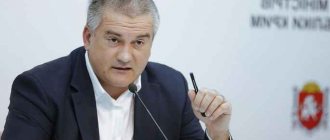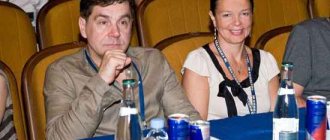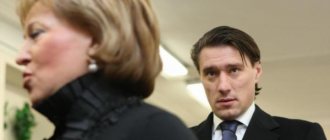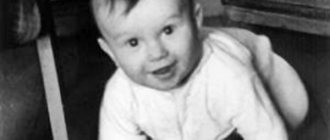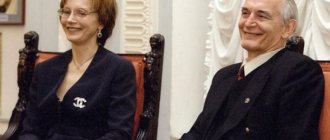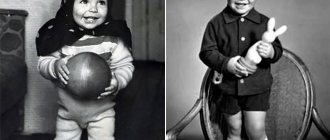Sergei Korolev is an outstanding Soviet scientist, designer of rocket and space systems, chairman of the Council of Chief Designers of the USSR. Academician of the USSR Academy of Sciences, who made an invaluable contribution to the development of astronautics.
Sergei Korolev is one of the main creators of Soviet rocket and space technology, which ensured strategic parity and made the USSR an advanced rocket and space power, and a key figure in human space exploration, the creator of practical astronautics.
Sergey Korolev
Under his leadership, the first artificial Earth satellite and the first cosmonaut on the planet, Yuri Gagarin, were launched (see interesting facts about Gagarin).
There are many interesting facts in Korolev’s biography, which we will tell you about right now.
So, here is a short biography of Korolev .
Biography Queen
Sergei Pavlovich Korolev was born on January 12, 1907 in Zhitomir. He was born into the family of teacher Pavel Yakovlevich and his wife Maria Nikolaevna.
When the future scientist was barely 3 years old, his father left the family. In this regard, little Seryozha was raised by his mother’s parents.
Childhood and youth
When Korolev was 10 years old, he moved to Odessa, where he lived with his mother. By that time, Maria Nikolaevna had remarried Grigory Balanin. As a teenager, the boy was keenly interested in aviation.
Sergei Korolev in his youth
During the biography period 1922-1924. Korolev studied at a construction school and also attended various clubs. Then he entered the Kiev Polytechnic Institute majoring in aviation technology. Later he transferred to Moscow to a higher technical school.
Personal tragedies in the life of Sergei Korolev
Early trauma
Sergei Korolev was born on January 12, 1907 in Zhitomir in the family of teachers Pavel Korolev and Maria Moskalenko. When the boy was not even three years old, his parents divorced, and Sergei was sent to live with his grandparents. He lived with them until he was 8 years old. Then Queen Jr. was taken to Odessa by her mother, who remarried.
Sergei grew up smart and inquisitive. He showed interest in aviation since childhood. His stepfather, who had an engineering education, had a great influence on the boy.
| Korolev always had many unique ideas in his head, but he prepared projects and transferred them to institutes and bureaus for further improvement to other institutes and bureaus. Sergei could abandon an almost completed project if he realized that something more relevant could be developed. The motto of the life of the young Korolev was the words “Forward!” and “Up!” “You bend, but don’t break. Bend and bend your line... And then you will straighten up. It’s nothing, it’s not scary,” Korolev assured his friends. Korolev’s talent manifested itself already in his young years: at the age of 17, Korolev developed a project for an aircraft of an original design - the “K-5 engineless aircraft.” From the age of 23, the talented designer was captivated by thoughts of flights into the stratosphere and the principles of jet propulsion. At the age of 28, he became the head of the rocket aircraft department, and at 31 he managed to bring cruise missiles to testing. Arrest and torture In 1938, when Korolev was 31 years old, he was arrested on charges of sabotage. Sergei was tortured. According to some reports, both jaws were broken during torture. Korolev himself admitted that the designer had to endure repression and bullying. However, it was impossible to prove this. In the same year, Korolev was included in the list of persons subject to trial by the Military Collegium of the Supreme Court of the USSR. He was in the first (execution) category on the list. The list was endorsed by Stalin, Molotov, Voroshilov and Kaganovich.
|
The first steps of Soviet rocket science
In September 1931, Sergei Korolev and a talented enthusiast in the field of rocket engines, Zander, achieved the creation of a public organization in Moscow - the Jet Propulsion Research Group (GIRD).
Less than a year later, it became essentially a state research and design laboratory for the development of rocket aircraft, in which the first Soviet liquid-ballistic missiles were created and launched.
Korolev and his like-minded people are working hard to create missile weapons, which the country desperately needed.
Later, the scientist formed the first design bureau from members of the Center for State Research and Development. During this period of his biography, Korolev laid the foundation for many projects related to rocket science.
Soon, the GIRD-09 liquid-propellant rocket was successfully launched. Sergei Korolev wrote about his achievements and experiments in the book “Rocket Flight in the Stratosphere.” He described in detail not only the properties of rockets, but also options for their use in various fields.
In 1933, 26-year-old Korolev was appointed to the post of deputy director of the Jet Institute. However, due to the fact that the transition to the expected projects did not happen, the next year the scientist was removed from his assigned position.
The talented guy continued to work at the institute as a simple engineer. At this stage of his biography, he was especially interested in cruise missiles.
Interesting facts from the biography:
- In 1921, he met the pilots of the hydraulic squadron and took part in aviation life: at the age of 16, he gave lectures on aviation. His first invention, created at the age of 17, was the K-5 motorless aircraft, recommended for construction.
- 1924-1926 – studied at the Kiev Polytechnic.
- In 1926 he was transferred to Moscow to a higher technical school. Participates in the organization of a glider school, becomes an instructor and tester of gliders, graduates from a pilot school, attends an aerodynamics club and develops light aircraft and gliders. Since his fourth year, he has been working at the design bureau.
Sergei Korolev in his youth
- Since 1927, he has participated in the All-Union Glider Competitions in Koktebel four times in a row.
- In 1929, he meets with K. E. Tsiolkovsky, who advises him to take up space flight, gives him the book “Space Rocket Trains” and recommends contacting Friedrich Arturovich Zander, an engineer at TsAGI (Central Aerohydrodynamic Institute).
- In February 1930, under the leadership of A.N. Tupolev defends the SK-4 aircraft project. At the same time, Korolev created the SK-3 “Red Star” glider, on which Nesterov’s loops were performed in free flight. The designer was unable to carry out the flight himself because he fell ill with typhus with complications such as deafness and memory loss. Before his illness, he had a phenomenal memory.
Sergei Korolev in his youth
- In March 1931, he began working at TsAGI as a senior flight test engineer. The main event of this period was a meeting with Zander, who was testing the OR-1 engine. Korolev also gets involved in the work. In September 1931, a group led by Zander began developing and testing the RP-1 rocket plane with a liquid engine.
Guided missile weapons
In 1936, Korolev became a key designer in the PHII department, which was involved in the creation of rocket aircraft. Thanks to his extensive knowledge and natural genius, he was the first to present a model of a missile interceptor fighter.
This aircraft could reach great heights in the shortest possible time and, if necessary, eliminate objects that pose a threat.
At the beginning of the tests, in which Korolev wanted to participate personally, an accident occurred. As a result, he was wounded in the head and urgently hospitalized.
When Sergei Pavlovich was discharged from the hospital in June 1938, he was arrested on charges of collaboration with the Trotskyists.
Sergei Korolev after his arrest. Butyrka prison, June 28, 1938
The designer was sentenced to 10 years in prison and exiled to Kolyma. This was one of the most difficult and terrible episodes in his biography.
However, when Soviet scientists continued to develop new weapons without their brilliant leader, they did not succeed. Without Korolev, they were unable to build the ultra-high-speed aircraft that the Soviet Union so needed.
Victory and trophies
In the fall of 1940, at the request of Tupolev, Sergei Korolev was returned from exile. In this regard, he was able to take part in the creation of a new bomber. Soon the Tu-2 aircraft was successfully tested and put into mass production.
Korolev continued to improve the aircraft missile launcher in the Kazan prison design bureau. For his work, he was awarded the Order of the Badge of Honor and was released.
In the mid-40s, Sergei Pavlovich created the D-1 and D-2 RDD projects with solid fuel motors. Soon information appears that such projects have already been implemented in Germany. The scientist is urgently sent to Germany to familiarize himself with the technology.
Later, Korolev states that the Soviet Union is also capable of producing similar missiles, which will have even better performance.
In the spring of 1946, large-scale development of rocket science began in the USSR. Not far from the capital, the State Union Research Institute of Jet Weapons (NII-88) is founded, where Korolev occupies one of the key positions.
Then events develop as follows:
- on Stalin's orders, an exact copy of the German rocket is being developed;
- A-4 and P-1 missiles are being tested.
Constructor Korolev
During his biography, Sergei Korolev showed himself to be an excellent scientist and an excellent organizer, who managed to coordinate the work of all sectors.
His missiles became more powerful and capable of covering ever greater distances. Below are missiles with rapidly increasing range:
- P-1 – 300 km;
- P-2 – 600 km;
- P-5M – 1,200 km;
- P-7 – 8,000 km;
- P-7A – 12,000 km.
An interesting fact is that the production of solid fuel missiles based on the RT-2 ICBM developed by Korolev continues today.
Personal life
Sergei Korolev was married twice. He first married in August 1931 to classmate Ksenia Vincentini, and in 1935 she gave birth to his daughter.
Sergei Korolev with his wife Ksenia and daughter | Day Online
In 1948, the family broke up.
Sergey Korolev and Nina Kotenkova | Personalities
He met his second wife, Nina Ivanovna Kotenkova, who was a translator at NII-88, at work.
Cosmonautics
Korolev was obliged to develop military weapons, because otherwise he would not have been allowed to explore space. On October 4, 1957, the USSR successfully launched the world's first artificial satellite. Then the 2nd satellite was sent into space with the dog Laika inside.
Then, under the direct leadership of Korolev, on April 12, 1961, Yuri Gagarin flew into space. This was a real triumph of Korolev's biography.
Over the years of his life, the scientist managed to implement 7 spacecraft flights, launch satellites and create space stations.

